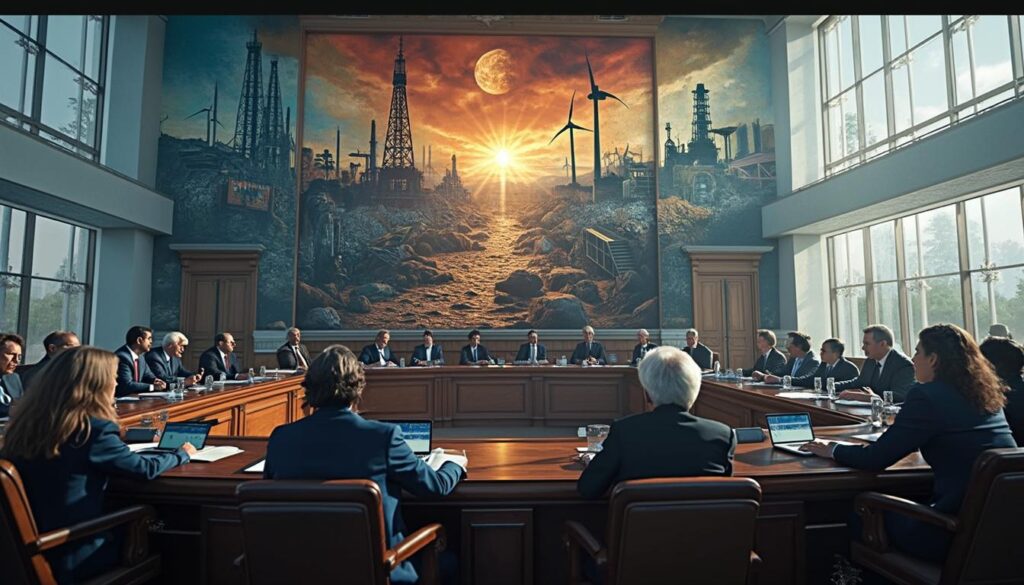Discover the energy transformation in the heart of Texas. The state has become an unquestioned leader in renewable energy installations. But new legislation threatens this momentum.
The evolution of ERCOT has allowed for massive integration of renewable energy, surpassing all other regions in the United States in terms of installed capacity. However, the SB 388 bill introduces significant obstacles by favoring traditional dispatchable generation. This decision could slow the growth of wind turbines and solar farms, thereby compromising Texas’s competitiveness in the national energy market. Renewable developers fear an increase in costs and a reduction in investments in green technologies. Meanwhile, fossil fuel industries seek to maintain their influence over the electrical grid. This tension underscores the complex challenges Texas must face to balance reliability and energy innovation. The consequences of this legislation could redefine the state’s energy landscape for years to come.
What is the measure adopted by the Texas Senate for renewable energy?
The Texas Senate recently adopted the SB 388 law, a controversial measure aimed at repealing renewable energy rules in the state. This legislation marks a significant turning point in Texas’s energy policy, historically dominated by fossil fuels. The SB 388 law mandates that 50% of new power plant capacity must come from sources of dispatchable generation other than battery energy storage. In practice, this favors fossil fuel installations like natural gas, while limiting the development of renewable energy sources such as wind and solar.
This legislative act also requires power plant owners and utilities to comply with this policy directive or risk having to purchase dispatchable generation credits. This measure has direct repercussions on the energy market, making renewable energy less competitive against traditional sources. According to Some business leaders, this decision could hinder the development of clean energy and increase energy costs for Texas consumers.
What are the motivations behind this legislation?
The motivations underlying the adoption of SB 388 are primarily political and economic. The fossil fuel industries, which have long dominated Texas’s energy landscape, see this measure as an opportunity to strengthen their position in the market. By favoring dispatchable energy sources, the Texas Senate responds to the pressures from these industries to maintain their profitability and political influence.
Moreover, supporters of the law argue that this measure is necessary to ensure the reliability of the electrical grid and counter federal subsidies for renewable energy. They assert that dispatchable energy sources offer the stability and predictability necessary to meet the growing demand for electricity, especially with the rise of new plants and data centers in Texas.
However, this legislation is seen by many as a reaction to the growing successes of renewable energy in the state. Indeed, Texas has recently installed more solar and wind capacity than any other U.S. state, aided by a competitive energy market and favorable investment conditions. The SB 388 law is thus viewed by proponents of clean energy as an attempt to slow this progression and protect the interests of traditional industries.
What are the potential impacts on the renewable energy market in Texas?
The implementation of SB 388 could have significant repercussions on the renewable energy market in Texas. By imposing strict requirements on the proportion of dispatchable generation, this law could discourage investments in solar and wind projects, which are becoming increasingly cost-competitive. Consequently, Texas may see a slowdown in the pace of new renewable capacity installations, despite technological advancements and the continuing decline in production costs.
Additionally, the requirement to purchase dispatchable generation credits could lead to an increase in electricity bills for consumers, as these credits represent an additional cost for energy providers. This increase in costs might also deter businesses from expanding in the state, thus limiting job creation in the renewable energy sector.
From an environmental perspective, this measure could slow progress made in reducing greenhouse gas emissions by favoring more polluting energy sources. Furthermore, the delay in the development of renewable energy could leave Texas lagging behind other U.S. states that continue to invest heavily in clean technologies. For example, international initiatives such as Linde’s commitment to renewable energy in India show a global trend towards decarbonization that could leave Texas behind if similar measures are not adopted elsewhere.
How does this law affect the reliability of the Texas electrical grid?
One of the main arguments put forth by supporters of SB 388 is that it would improve the reliability of the Texas electrical grid. They argue that dispatchable generation sources, like natural gas plants, provide a more stable and predictable energy output than intermittent renewable energies such as solar and wind. By reinforcing this dependence on fossil fuels, the Senate aims to ensure a continuity of electricity supply even during peak demand or extreme weather conditions.
However, renewable energy experts and some electrical consultants contest this claim. They point out that renewable energies, combined with energy storage solutions like batteries, can also ensure comparable or even superior reliability. For instance, during the heat waves of summer 2023, solar installations and battery storage systems played a crucial role in stabilizing the Texas electrical grid and preventing massive outages.
Moreover, the diversity of energy sources contributes to greater resilience of the grid. By betting on a range of renewable technologies and storage options, Texas could better manage fluctuations in demand and unforeseen climatic events. The increase in renewable capacities could thus complement existing infrastructures, providing a reliable alternative to traditional sources and reducing the network’s vulnerability to disruptions.
What are the reactions from energy sector stakeholders?
The reception of SB 388 by energy sector stakeholders in Texas has been largely negative, particularly among proponents of renewable energies and advocates for energy transition. Many companies and consultants, such as those from the Advanced Power Alliance, believe that this law hinders the development of clean infrastructures and slows innovation in the sector.
Critics argue that the SB 388 law could discourage investments in renewable technologies, thereby stifling Texas’s competitiveness in the national and international clean energy markets. They also warn of rising energy costs for consumers, highlighting that the dispatchable credits imposed by the law could lead to higher electricity bills.
On the other hand, fossil fuel supporters view this measure as a necessary defense against what they perceive as excessive government interference in the energy market. They argue that prioritizing the least costly energy sources ensures greater economic efficiency and protects consumers from fluctuations in the fossil fuel market.
This division within the energy sector reflects a broader struggle between traditional fossil fuel interests and aspirations towards a sustainable energy transition. The debates surrounding SB 388 illustrate the growing tensions between these two visions of Texas’s energy future.
What are the long-term political and economic stakes?
The adoption of SB 388 raises crucial questions about Texas’s energy and economic future. In the long term, the decision to favor fossil fuels could limit the state’s ability to adapt to global shifts towards a low-carbon economy. As the United States and other nations ramp up their efforts to reduce greenhouse gas emissions, Texas risks losing its leadership position in renewable energy if similar policies are not adopted elsewhere.
Economically, Texas could find itself lagging in the global race for energy innovation. Countries like Germany, China, and India are heavily investing in green technologies, creating dynamic markets and skilled jobs. In contrast, Texas may see a decrease in job opportunities in the emerging renewable energy sectors, exacerbating regional economic imbalances.
Politically, this measure also heightens tensions among different energy stakeholders and policymakers. An increased reliance on fossil fuels could strengthen the influence of traditional lobbies, limiting politicians’ ability to promote ambitious environmental policies. Additionally, this could affect Texas’s relationships with other states and international partners engaged in the energy transition.
Conversely, by maintaining a strong presence in fossil fuels, Texas could benefit from stability and continuity in a market it is accustomed to. However, this approach could prove unsustainable in the face of increasing volatility in fossil fuel markets and regulatory pressures to reduce carbon emissions.
What alternatives exist to support renewable energy in Texas?
In light of the adoption of SB 388, several alternatives could be considered to support and promote renewable energy in Texas. One of the main strategies is to strengthen tax incentives and subsidies for clean energy projects, compensating for the new obligations imposed by the legislation. Initiatives like Linde NTPC, which plans to invest heavily in renewable energy, demonstrate that there are still investment opportunities despite regulatory challenges.
Another alternative is to encourage public-private partnerships to develop advanced energy storage infrastructures, facilitating the integration of renewable energies into the Texas electrical grid. Innovative large-scale battery projects can provide increased flexibility to the grid, allowing for smoothing production fluctuations and effectively responding to demand peaks.
In addition, the state could adopt carbon pricing policies or emission trading mechanisms to internalize the environmental costs of fossil fuels, thus making renewable energy more competitive without resorting to restrictive measures. These market-based approaches could offer a smoother transition to a renewable economy, encouraging innovation and compelling businesses to adopt sustainable practices.
Finally, raising public awareness and promoting a culture of clean energy through educational campaigns and training programs can play a crucial role. By engaging local communities and highlighting the benefits of renewable energy, Texas could generate increased demand for clean technologies, thereby reinforcing the political and economic support necessary for a successful energy transition.
How are other U.S. states reacting to similar measures?
Texas is not the only U.S. state debating the regulation of renewable energy. Other states are adopting varied approaches, often inspired by local political and economic dynamics. For instance, some states on the East Coast and in the Midwest are strengthening their commitments to clean energy by offering subsidies and establishing ambitious energy transition goals.
In contrast, states like Florida or Oklahoma might follow a path similar to Texas, prioritizing fossil fuels in the face of pressures from established industries. This diversity of energy policies across the United States reflects the national debates concerning energy security and the fight against climate change. Each state must balance its economic, environmental, and political priorities to determine the best path forward.
At the national level, federal legislation also plays a crucial role in the direction taken by the states. Initiatives like the Green New Deal or the latest climate bills aim to harmonize the efforts of different states for a coherent and effective energy transition. However, the implementation of such policies largely depends on cooperation between federal and state governments, as well as the political will to transcend the specific interests of dominant industries.
Ultimately, the reaction of other U.S. states to measures similar to SB 388 will depend on the evolution of energy markets, technological advancements in renewable energies, and internal political dynamics. Texas, as a traditional leader in the fossil fuel sector, could influence national trends but will also have to navigate an energy landscape that is changing rapidly.
What are the arguments from opponents of SB 388?
Opponents of SB 388 present several strong arguments to contest this measure. Among the most common concerns is that this law could hinder the growth of renewable energy and delay the transition to a more sustainable economy. They argue that clean energies, such as solar and wind, offer more environmentally friendly and economically viable solutions in the long run compared to fossil fuels.
Moreover, critics highlight the economic benefits of renewable energy, particularly job creation and technological innovation. By limiting the expansion of renewable infrastructures, SB 388 could reduce job opportunities and stifle the growth of new dynamic industries in Texas. This could also deter foreign and national investments in the clean energy sector, limiting the state’s competitiveness in the global market.
Opponents also emphasize that renewable energies contribute to the resilience and stability of the electrical grid by diversifying energy sources. If one specific source fails, others can compensate, thereby reducing the risk of widespread outages. They argue that investing in energy storage and smart grid management technologies can amplify these benefits without sacrificing energy reliability.
Finally, critics also point to the environmental consequences of fossil fuels, including greenhouse gas emissions and air pollution. By decreasing the share of clean energies, SB 388 could exacerbate environmental issues and make it more difficult to meet Texas’s and the U.S.’s climate targets. For instance, a recent report highlighted the risks associated with greenwashing in Europe, a phenomenon that opponents fear may also emerge in Texas.
What is the future of renewable energy in Texas despite the obstacles?
Despite the challenges posed by SB 388, the future of renewable energy in Texas remains promising due to several favorable factors. Texas has immense potential for solar and wind, benefiting from vast open spaces and ideal climatic conditions for clean energy production. The state is also a leader in technological innovation in the field of energy storage, which could offset current regulatory obstacles.
Furthermore, the growing demand for renewable energy, both from consumers and businesses, continues to drive investment in this sector. Tech companies and emerging industries increasingly seek to reduce their carbon footprint, thereby creating additional pressure to develop sustainable energy solutions. Additionally, private initiatives and public-private partnerships, such as those discussed in projects in Uruguay, demonstrate the resilience and adaptability of renewable energy stakeholders.
Moreover, technological advancements continue to make renewable energies increasingly competitive. The production costs of solar and wind energy have significantly decreased over the past decade, making these energy sources more accessible and attractive to investors. The development of new energy storage and smart grid technologies can also enhance the integration of renewable energies, thereby increasing their share in the Texas energy mix despite restrictive regulations.
Finally, international pressure and climate commitments may force Texas to reconsider its energy policies. With the rise of global initiatives to combat climate change, the state may be prompted to adjust its legislation to remain competitive and aligned with global environmental objectives. Collaborating with other states and participating in regional clean energy alliances could also open up new perspectives for renewable energies in Texas.
What are the international examples of similar conflicts?
The conflict between traditional fossil fuel interests and the development of renewable energy is not unique to Texas. Internationally, many countries face similar challenges in balancing their energy needs with environmental and economic imperatives. For example, in Europe, some countries have been criticized for their greenwashing, a practice where “green” initiatives are more about communication tools than genuine commitments to renewable energy. A recent report highlighted how Europe benefits from greenwashing to enhance its eco-friendly image without necessarily reducing its dependence on fossil fuels.
In the Middle East, ambitious projects such as those announced by NTPC demonstrate a growing commitment to renewable energy, but often encounter resistance from established oil and gas industries. Similarly, in Uruguay, the renewable energy revolution showcases how government policies can facilitate an energy transition, though not without opposition.
In the United States, in addition to Texas, states like Florida and Oklahoma are considering policies that favor fossil fuels, sometimes at the expense of renewable energies. These tensions reflect a broader struggle within the country regarding the path forward in energy policy, influenced by economic, political, and cultural factors unique to each region.
These international examples highlight the complexity of energy transitions and the need for a delicate balance between various economic and environmental interests. They also underscore the importance of consistent policies and collaboration between the public and private sectors to effectively promote renewable energies while ensuring economic and energy stability.
What lessons can be learned from this situation?
The adoption of SB 388 by the Texas Senate offers several important lessons for policymakers, economic stakeholders, and advocates of renewable energies. First, it is essential to recognize the importance of a balanced regulatory framework that promotes both the reliability of the electrical grid and the growth of clean energies. Overly burdensome legislation on renewable energies can stifle innovation and investment, thereby compromising long-term environmental and economic goals.
Next, this situation underscores the necessity for constructive dialogue among different energy stakeholders. Collaboration between fossil fuel and renewable energy industries, as well as with governments, can lead to hybrid solutions that maximize the benefits of both sectors. For example, integrating energy storage technologies and smart grid management systems could create a more resilient and adaptable environment.
Furthermore, it is crucial to promote a culture of transparency and accountability in energy decisions. Policies should be based on solid scientific data and aim to minimize environmental impacts while supporting economic growth. Initiatives like those seen in Uruguay show that well-designed policies can catalyze a successful energy transition.
Finally, this situation highlights the importance of community engagement and public education. Informing citizens about the benefits of renewable energies and encouraging them to participate actively in the energy transition can strengthen support for clean energy-friendly policies. Surveys, such as we invite you to participate in our latest study on solar energy, can also provide valuable feedback to guide policy decisions in a more inclusive and democratic manner.
What are the expected upcoming developments?
In the near future, several key developments are anticipated in the context of SB 388 and Texas’s energy policy. First, the law will need to be reviewed by the Texas House, the next legislative step. Debates within the House could influence the final provisions of the law, and its adoption will largely depend on the support of legislators. Additionally, the governor will play a crucial role in deciding whether to sign the bill, based on his priorities and political alliances.
In parallel, the business community and investors will closely monitor the implications of SB 388 on the energy market. A potential increase in energy costs could alter investment strategies and prompt more companies to explore alternatives to maintain their competitiveness. Companies in the renewable energies sector will also need to adapt to this new regulatory environment, innovating to reduce costs and improve the efficiency of their technologies.
On the technological front, advancements in energy storage and smart grids could offer solutions to mitigate the negative effects of SB 388. Ongoing innovations in these areas are essential to ensure a successful energy transition, even within a regulatory framework that is less favorable to traditional renewables.
Finally, external pressures, such as international climate commitments and global economic trends towards clean energies, could influence Texas’s future decisions. The need to align with greenhouse gas emission reduction objectives and participate in a transitioning global economy may eventually compel Texas lawmakers to reassess or adjust their stance on renewable energies.
In summary, the coming months will be crucial for the evolution of the energy sector in Texas, with significant implications for the future of renewable energies in the state and beyond.
Articles similaires
Thank you!
We will contact you soon.














